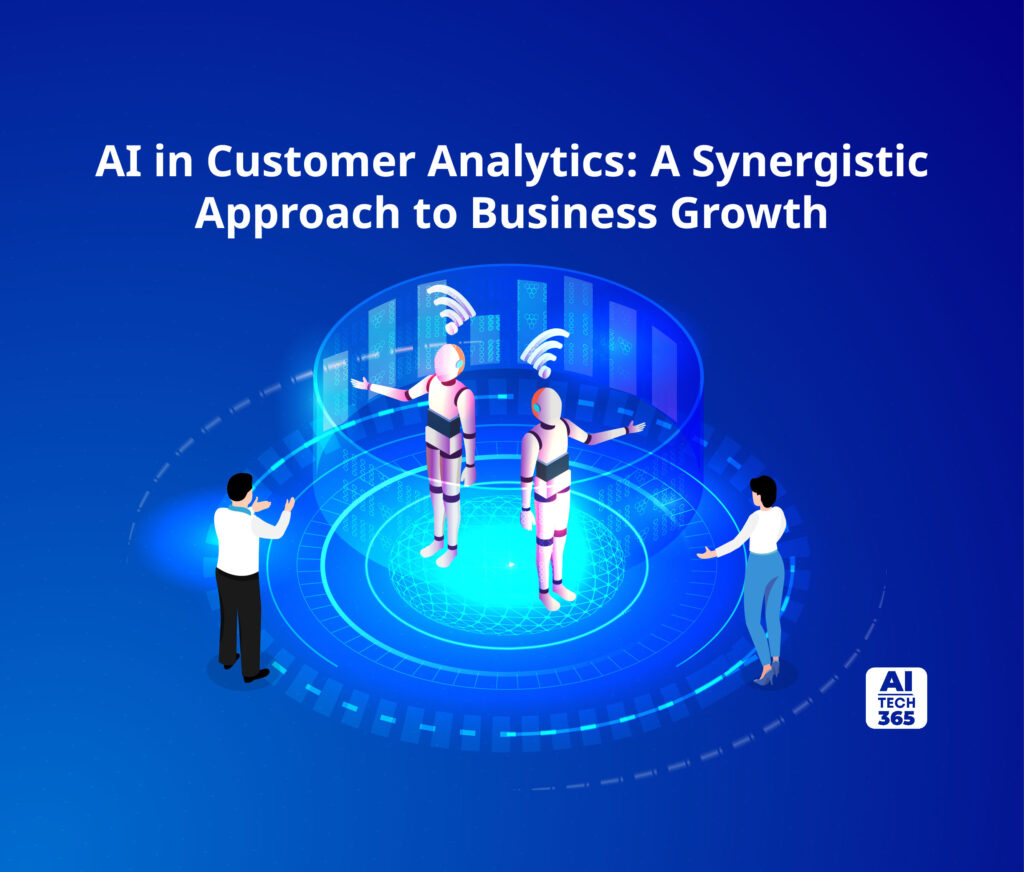Ever wondered how businesses seem to anticipate your every need? The secret lies in the dynamic realm of ‘AI in customer analytics’. This isn’t just about data – it’s about decoding the language of customer behavior, unveiling patterns, and predicting preferences with unprecedented accuracy.
Ready to uncover the science behind anticipating customer whims? Let’s delve into the world where AI and analytics converge to shape the future of customer relationships.
What is AI in Customer Analytics?
AI in customer analytics uses artificial intelligence techniques to analyze customer data, automating and enhancing insights into behaviors, preferences, and needs. Leveraging machine learning and natural language processing, businesses can uncover hidden patterns, predict behavior, personalize campaigns, and optimize experiences. AI-powered analytics streamlines the decision-making process, providing actionable insights and saving time and resources for agile responses to changing customer dynamics.
Why is AI in Customer Analytics Important?
With priceless insights into consumer behavior, preferences, and trends, using AI for customer analytics plays a critical role in revolutionizing enterprises. Using sophisticated algorithms and machine learning, artificial intelligence (AI) helps businesses quickly evaluate large datasets and spot patterns and correlations that would be difficult to find using conventional techniques.
In the end, this facilitates well-informed decision-making by enabling firms to maximize engagement, tailor client experiences, and anticipate emerging trends. In today’s data-driven market, companies can gain a competitive edge by optimizing marketing strategies, enhancing customer satisfaction, and fostering everlasting client loyalty through the utilization of AI in customer analytics.
Also Read: The Ultimate Guide to Using AI in Customer Service
Technologies Powering AI in Customer Analytics
● Natural language processing
Through text analysis, natural language processing (NLP) enables a machine to comprehend human language, complete with emojis, linguistic nuances, and colloquialisms. Natural language generation (NLG) and natural language understanding (NLU) are two more AI subtasks that NLP uses to achieve this. AI-driven chatbots and smart assistants are powered by NLU and NLG, enabling them to provide better, 24/7 customer service. The integration of AI in customer service ensures seamless interactions and efficient problem resolution.
● Sentiment analysis
Sentiment analysis is a useful tool for determining how people feel about your brand or services since it can identify sentiments or emotions in data. The system recognizes sentiment in reviews from a variety of sources, including news sources, surveys, social media comments, and direct mentions, sites like Google My Business and Trustpilot, and questionnaires.
● Predictive analytics
By leveraging AI in customer analytics to analyze patterns in consumer behavior, predictive analytics can foresee future demands. It is employed to maximize the impact of brand promotions, organize supply chain and logistics, and optimize sales. Retailers, for instance, can forecast fluctuations in foot traffic based on location, events, or seasons by analyzing consumer data and allocating resources appropriately.
● Machine learning
By using machine learning (ML), vast volumes of data may be automatically mined for insights. Text parsing, feature categorization, and topic extraction are among the subtasks that AI systems employ machine learning to automate in order to do text analysis and sentiment analysis.
These models use artificial neural networks (ANNs) for data analysis in order to recognize and correlate patterns in the data, as well as to learn as they go. In order to deliver increasingly precise insights over time, they can delve into audience demographics, interests, hot topics, and other elements when processing customer experience data.
Spotify is one example of how this is done to enhance content recommendations through machine learning. It provides tailored recommendations across musical genres, playlists, and podcasts, predicting what customers might enjoy based on their current listening preferences.
● Named entity recognition
A computer can recognize significant names that appear in data by using named entity recognition (NER). These identified entities—which are required for competitive analysis—could be individuals, companies, currencies, or geographical locations. Millions of data points can be recognized by a NER model, which can then be used in situations specific to a given industry.
● Computer vision
Computer vision is used for optical character recognition (OCR), which enables a system to find patterns in large amounts of image-based data. In order to conduct competitive analysis, target advertising, and identify celebrities, companies, and items on social media platforms, this technology is frequently used to identify problems with customers.
Examples of AI in Customer Analytics Worth Exploring
- Personalized Recommendations: For the purpose of making tailored suggestions for products or content, AI algorithms examine consumer data, including browsing patterns, past purchases, and preferences. For instance, based on a user’s viewing history, Netflix utilizes AI to propose films and TV series.
- Customer Segmentation: AI is capable of segmenting customers into specific categories according to their preferences, behavior, or demographics by analyzing consumer data. Businesses may better target particular client groups with their marketing tactics and products thanks to this segmentation.
- Call Transcription and Analytics: Utilizing AI in customer analytics, businesses can leverage advanced technologies to record and analyze customer service calls. This enables the identification of trends, and improvement of call quality, and provides valuable insights to educate customer care representatives. The integration of AI enhances businesses’ understanding of client preferences, challenges, and service trends, fostering a more informed and responsive approach to customer interactions.
- Performance Tracking and Measurement: Real-time tracking and measurement of consumer engagement, satisfaction, and performance against key parameters can be achieved with AI-powered analytics solutions. This aids companies in tracking and refining their CX strategies. For example, Amazon suggests items (such as cosmetics, sneakers, books, etc.) based on your past purchases and those of customers with similar purchases.
Wrapping It Up
In the ever-evolving business landscape, leveraging AI in customer analytics isn’t just a choice—it’s a strategic imperative. The power to anticipate, understand, and resonate with customer needs positions businesses at the forefront of innovation and success. Through the lens of AI in customer insights, it transforms from a static snapshot to a dynamic narrative, enabling businesses to not only respond but to proactively shape customer experiences. In this fusion of technology and insights, the future unfolds, promising a customer-centric paradigm where AI paints the canvas of tomorrow’s business success.

